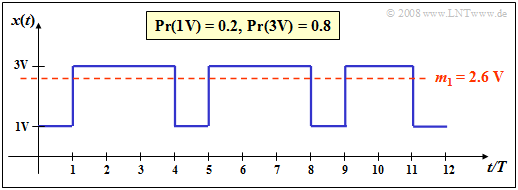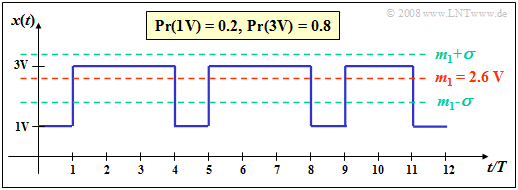Contents
Calculation as ensemble average or time average
The probabilities and the relative frequencies provide extensive information about a discrete random variable.
Reduced information is obtained by the so-called moments $m_k$, where $k$ represents a natural number.
$\text{Two alternative ways of calculation:}$
Under the condition "Ergodicity" implicitly assumed here, there are two different calculation possibilities for the $k$-th order moment:
- the ensemble averaging or "expected value formation" ⇒ averaging over all possible values $\{ z_\mu\}$ with the index $\mu = 1 , \hspace{0.1cm}\text{ ...} \hspace{0.1cm} , M$:
- $$m_k = {\rm E} \big[z^k \big] = \sum_{\mu = 1}^{M}p_\mu \cdot z_\mu^k \hspace{2cm} \rm with \hspace{0.1cm} {\rm E\big[\text{ ...} \big]\hspace{-0.1cm}:} \hspace{0.3cm} \rm expected\hspace{0.1cm}value ;$$
- the time averaging over the random sequence $\langle z_ν\rangle$ with the index $ν = 1 , \hspace{0.1cm}\text{ ...} \hspace{0.1cm} , N$:
- $$m_k=\overline{z_\nu^k}=\hspace{0.01cm}\lim_{N\to\infty}\frac{1}{N}\sum_{\nu=\rm 1}^{\it N}z_\nu^k\hspace{1.7cm}\rm with\hspace{0.1cm}horizontal\hspace{0.1cm}line\hspace{-0.1cm}:\hspace{0.1cm}time\hspace{0.1cm}average.$$
Note:
- Both types of calculations lead to the same asymptotic result for sufficiently large values of $N$.
- For finite $N$, a comparable error results as when the probability is approximated by the relative frequency.
First order moment – linear mean – DC component
$\text{Definition:}$ With $k = 1$ we obtain from the general equation the first order moment ⇒ the linear mean:
- $$m_1 =\sum_{\mu=1}^{M}p_\mu\cdot z_\mu =\lim_{N\to\infty}\frac{1}{N}\sum_{\nu=1}^{N}z_\nu.$$
- The left part of this equation describes the ensemble averaging (over all possible values),
- while the right equation gives the determination as time average.
- In the context of signals, this quantity is also referred to as the "direct current" $\rm (DC)$ component.
$\text{Example 1:}$ A binary signal $x(t)$ with the two possible values
- $1\hspace{0.03cm}\rm V$ $($for the symbol $\rm L)$,
- $3\hspace{0.03cm}\rm V$ $($for the symbol $\rm H)$
as well as the occurrence probabilities $p_{\rm L} = 0.2$ and $p_{\rm H} = 0.8$ has the linear mean ("DC component")
- $$m_1 = 0.2 \cdot 1\,{\rm V}+ 0.8 \cdot 3\,{\rm V}= 2.6 \,{\rm V}. $$
This is drawn as a red line in the graph.
If we determine this parameter by time averaging over the displayed $N = 12$ signal values, we obtain a slightly smaller value:
- $$m_1\hspace{0.01cm}' = 4/12 \cdot 1\,{\rm V}+ 8/12 \cdot 3\,{\rm V}= 2.33 \,{\rm V}. $$
- Here, the probabilities $p_{\rm L} = 0.2$ and $p_{\rm H} = 0.8$ were replaced by the corresponding frequencies $h_{\rm L} = 4/12$ and $h_{\rm H} = 8/12$ respectively.
- In this example the relative error due to insufficient sequence length $N$ is greater than $10\%$.
$\text{Note about our (admittedly somewhat unusual) nomenclature:}$
We denote binary symbols here as in circuit theory with $\rm L$ ("Low") and $\rm H$ ("High") to avoid confusion.
- In coding theory, it is useful to map $\{ \text{L, H}\}$ to $\{0, 1\}$ to take advantage of the possibilities of modulo algebra.
- In contrast, to describe modulation with bipolar (antipodal) signals, one better chooses the mapping $\{ \text{L, H}\}$ ⇔ $ \{-1, +1\}$.
Second order moment – power – standard deviation – variance
$\text{Definitions:}$
- Analogous to the linear mean, $k = 2$ is obtained for the second order moment ⇒ the quadratic mean:
- $$m_2 =\sum_{\mu=\rm 1}^{\it M}p_\mu\cdot z_\mu^2 =\lim_{N\to\infty}\frac{\rm 1}{\it N}\sum_{\nu=\rm 1}^{\it N}z_\nu^2.$$
- $m_2$ indicates also the total power $P$ (DC power plus AC power) of a random signal, referenced to $1 \hspace{0.03cm} Ω$ resistance. The square root $\sqrt{P}$ is called "standard deviation".
- Together with the DC component $m_1$, the variance $σ^2$ can be determined from the second order moment as a further parameter ("Steiner's theorem"):
- $$\sigma^2=m_2-m_1^2.$$
- The square root $σ$ of the variance is called "standard deviation":
- $$\sigma=\sqrt{m_2-m_1^2}.$$
$\text{Notes on units:}$
- For message signals, $m_2$ indicates the total power (DC power plus AC power) of a random signal, referenced to $1 \hspace{0.03cm} Ω$ resistance.
- If $z$ describes a voltage, $P=m_2$ accordingly has the unit ${\rm V}^2$, and the "standard deviation" has the unit ${\rm V}$.
- The variance $σ^2$ of a random signal corresponds physically to the "alternating power" or "AC power".
- These definitions are based on the reference resistance $1 \hspace{0.03cm} Ω$.
The following (German language) learning video illustrates the defined quantities using the example of a digital signal:
Momentenberechnung bei diskreten Zufallsgrößen ⇒ "Moment Calculation for Discrete Random Variables".
$\text{Example 2:}$ A binary signal $x(t)$ with the two possible values
- $1\hspace{0.03cm}\rm V$ $($for the symbol $\rm L)$,
- $3\hspace{0.03cm}\rm V$ $($for the symbol $\rm H)$
as well as the occurrence probabilities $p_{\rm L} = 0.2$ and $p_{\rm H} = 0.8$ has the total signal power
- $$P_{\rm total} = 0.2 \cdot (1\,{\rm V})^2+ 0.8 \cdot (3\,{\rm V})^2 = 7.4 \hspace{0.05cm}{\rm V}^2,$$
if one assumes the reference resistance $R = 1 \hspace{0.05cm} Ω$ .
With the DC component $m_1 = 2.6 \hspace{0.05cm}\rm V$ $($see $\text{Example 1})$ it follows for
- the variance $σ^2 = 7.4 \hspace{0.05cm}{\rm V}^2 - \big [2.6 \hspace{0.05cm}\rm V\big ]^2 = 0.64\hspace{0.05cm} {\rm V}^2$,
- the alternating power $P_{\rm AC} = 0.64\hspace{0.05cm} {\rm W}$ ⇒ same numerical value as $σ^2$, but different unit,
- the standard deviation $s_{\rm eff} = σ = 0.8 \hspace{0.05cm} \rm V$.
- Insertion: With other reference resistance ⇒ $R \ne 1 \hspace{0.1cm} Ω$, not all these calculations apply. For example, with $R = 50 \hspace{0.1cm} Ω$, the power $P_{\rm total} $, the alternating power $P_{\rm AC}$, and the standard deviation $s_{\rm eff}$ have the following physical values:
- $$P_{\rm total} \hspace{-0.05cm}= \hspace{-0.05cm} \frac{m_2}{R} \hspace{-0.05cm}= \hspace{-0.05cm} \frac{7.4\,{\rm V}^2}{50\,{\rm \Omega} } \hspace{-0.05cm}= \hspace{-0.05cm}0.148\,{\rm W},\hspace{0.5cm} P_{\rm AC} \hspace{-0.05cm} = \hspace{-0.05cm} \frac{\sigma^2}{R} \hspace{-0.05cm}= \hspace{-0.05cm}12.8\,{\rm mW} \hspace{0.05cm},\hspace{0.5cm} s_{\rm eff} \hspace{-0.05cm} = \hspace{-0.05cm}\sqrt{R \cdot P_{\rm W} } \hspace{-0.05cm}= \hspace{-0.05cm} \sigma \hspace{-0.05cm}= \hspace{-0.05cm} 0.8\,{\rm V}.$$
- Insertion: With other reference resistance ⇒ $R \ne 1 \hspace{0.1cm} Ω$, not all these calculations apply. For example, with $R = 50 \hspace{0.1cm} Ω$, the power $P_{\rm total} $, the alternating power $P_{\rm AC}$, and the standard deviation $s_{\rm eff}$ have the following physical values:
The same variance $σ^2 = 0.64\hspace{0.05cm} {\rm V}^2$ and the same standard deviation $s_{\rm eff}= 0.8 \hspace{0.05cm} \rm V$ are obtained for amplitudes $0\hspace{0.05cm}\rm V$ $($for symbol $\rm L)$ and $2\hspace{0.05cm}\rm V$ $($for symbol $\rm H)$, provided that the probabilities $p_{\rm L} = 0.2$ and $p_{\rm H} = 0.8$ remain the same. Only the DC component and the total power change:
- $$m_1 = 1.6 \hspace{0.05cm}{\rm V}, \hspace{0.5cm}P_{\rm total} = {m_1}^2 +\sigma^2 = 3.2 \hspace{0.05cm}{\rm V}^2.$$
Exercises for the chapter
Exercise 2.2: Multi-Level Signals
Exercise 2.2Z: Discrete Random Variables

